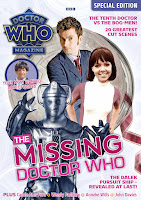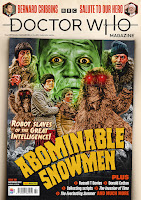Earlier this month, at a lunch to celebrate my great-aunt's 90th birthday, I was surprised to learn that she'd worked in Hut 3 at
Bletchley Park in the war, translating the top secret messages snaffled from the enemy. I asked her what she remembered of her time there.
"The cold," she said.
I asked her about the work she'd done, and - since she spoke French and German - what secret stuff she might have been privy to. She took my arm and leaned forward earnestly.
"You must understand," she said, and I expected her to tell me that it was all too long ago, or that there was still an obligation not to speak of it. But she went on: "It was
perishing cold."
The next day, my dad sent me a link to
my great-aunt Althea's memories of her time at Bletchley Park, and the
Infinite Monkey Cage on Radio 4 devoted an episode to Bletchley Park and code-breaking with special guest Dr Sue Black. I also stared reading
Secret Days - historian
Asa Briggs' account of his own time at BP, published in 2011 as Briggs turned 90.
The Dr is a big fan of Briggs - especially his books on the Victorians and his history of broadcasting in the UK - and went to hear him speak recently.
Secret Days is a little disappointing, too rambling and anecdotal and more like an extended interview than a comprehensive history in itself. The best bits, the Dr felt, are the 36-page introduction to BP, the nine-page "Selected Chronology" and the six-page "Further Reading".
This latter section is exhaustive, with a good sense of how accounts have developed as BP's secret work has been declassified over the years. There's a huge and growing amount of material on the subject, and Briggs himself admits that his own contribution is not the place to start. Rather, it's a response to this huge wealth of material, his own memories of what he did and its context while he's still able to share them. As he says in the book - and the Dr said happened when she went to see him - Briggs is asked more about his short time at BP than any other part of his life and work.
What is the appeal of BP? I've argued before that the interest in spies is the idea of one man (it is usually a man) with only his wits and courage, working against all the odds in the midst of enemy territory. With BP, there's a sense of brain beating brawn, the boffins in their freezing huts running rings round the brute force of the Nazis. It's more complicated than that - and Briggs details his own rough treatment in training, by soldiers who didn't appreciate brains - but BP still offers a not-quite fantasy of geeks winning the war.
Briggs acknowledges this interest with good grace - and deserved pride - and says in his (very good) introduction that he felt obliged to give this testimony of his time. The book needs to be read in that context - not as a definitive work on the subject but as an additional source. Often, he directs us to other sources or accounts with a cursory remark.
“A memorandum by [Brigadier ET] Williams [Montgomery's intelligence chief] on the use of Ultra in the field in military operations (WO208/3575), labelled Top Secret, is one of the most interesting documents on the subject produced during the war.”
Asa Briggs, Secret Days (2011), p. 18.
But there are nuggets of telling detail and concise, clear exposition that attest to his skill as a historian. Briggs mentions an awful lot of people and the ways they are connected, which is quite a tangle in my head. But there are also great asides about interesting characters.
“The great city of Smyrna in Asia Minor in which George McVittie, head of the BP section cracking weather codes, was born was an unusual starting point for many of his later journeys. After the war he taught mathematics at King's College, London, where one of his pupils was the writer of science-fiction, Arthur C. Clarke. McVittie subsequently crossed the Atlantic to the University of Illinois, where he worked in radio astronomy, building a radio telescope. In 1958 his colleagues published in Nature some of the earliest orbital data relating to Sputnik 1.”
Ibid., p. 50.
There's nice little details, too, like naming the civil servant, Martin Roseveare, at the Ministry of Food, who was,
“said to have invented the ration card and the points system.”
Ibid., p. 62.
He's also good on other telling details, describing how a Welsh colleague was taken in for questioning by the authorities because of his suspiciously un-Anglo Saxon name:
Hrothgar Habakkuk.
“Hugh Trevor-Roper was to have a somewhat similar experience in 1940. Strolling through the Cornish countryside and looking, as he admitted, scruffy in his unbuttoned uniform, he was arrested by the Home Guard on suspicion of being a spy.”
Ibid., p. 57.
Even so, Briggs and his friends were still writing to each other in German - discussing obscure German poetry, apparently - without incurring the wrath of the censor. I loved these rare, strange insights, so unlikely and so real.
Briggs is excellent, too, on what exactly was needed to break the German cyphers - and keen to correct the idea that BP was all genius mathematicians. Briggs doesn't stint in his praise for Turing, but also places his work alongside the other people at BP. For one thing, there were 10,000 people at BP at its peak. But Briggs also argues that historians - like himself - had a particular skill set that was vital to BP's work. It wasn't only maths and the invention of the computer.
The key thing was to spot "cribs" - or anticipate words and phrases that the coded messages would contain. That might be the use of the same opening or closing words, proper nouns such as place names or commanding officers, "Heil Hitler" or messages that comprised nothing but "Nicht zu melden" ("Nothing to report").
“Historians could make excellent cribsters since they were usually well-read, drawn to lateral thinking, and taught to get inside the mind of people totally different from themselves. Senders were good prey. Many Y Service interceptors would have made good cribsters too. They were capable of imagining what their German opposite numbers were like by tracking their habits and styles which did not change when there were changes in the frequencies they were using and even the keys. Many what might be thought of as 'hunches' were genuine insights. Concentration and insight were almost as valuable BP qualities as mathematics, and fortunately many mathematicians, such as Herivel, possessed them.”
Ibid., p. 78
This made me think of two things. First, it chimed with
CP Snow's 1959 lecture on The Two Cultures, and the importance of the sciences and humanities working together. Snow, Briggs reveals, was involved in recommending Oxbridge graduates for intelligence work - including at BP. He was, Briggs recalls,
“the ugliest man I had ever seen”.
Ibid., p. 57.
Second, it reminded me of Commander Millington in
Doctor Who and the Curse of Fenric, sitting in an exact replica of his German opposite number's rooms, to “think the way the Germans think”. That always seemed a rather fanciful idea to me, but Briggs gives it much more credence. (I'm assuming Ian Briggs, who wrote
Fenric, is not a relation of Asa's.)
Briggs then proceeds to concisely explain the “technical side to cribbing”, including three key features without which BP's work would have been much harder:
“First, the machine would never show up the same letter in an encrypted message as was there in the original text. A would never appear as A; any other letter was possible. Second, the letter coding was reciprocal: if A appeared as B, B would appear as A. Third, Enigma did not encrypt numbers: the numbers always had to be spelt out in letters.”
Ibid., p. 78
But the work owed as much to lateral thinking, psychology and human foibles as it did to mechanical factors:
“Likewise – and this had nothing to do with the make-up of a machine – it would have been difficult for decypherers to find enough letters to make up a menu from a crib had not the Germans liked to incorporate the names, ranks and addresses of the senders and receivers in their texts. They also like going over old ground in standard format when they dealt with supply, administration and planned schedules.”
Ibid., p. 79
Briggs also talks of an attitude to intelligence work at BP, reflected in the way its huge number of staff still kept the secret well into the 1970s and beyond. My great-aunt still rather sees the declassification of material about Enigma as a distasteful lapse in security. The back cover of
Secret Days says,
"Briggs himself did not tell his wife about his wartime career until the 1970s and his parents died without ever knowing about their son's contribution to the war effort."
He's good on the different stages at which things were made public, and the battles fought to keep them secret. He explains how not being able to mention the work they'd done in the war affected some people finding work later. Again, he's often good on the detail of this covert stuff:
“Enigma was never referred to as such. Synonyms included 'Boniface', 'an unimpeachable source', and, simplest of all, 'special stuff'.”
Ibid., p. 95.
He's withering about Ian Fleming, too, and seems - without quite spelling it out - to be particularly appalled at Fleming's indiscretion in naming his Jamaican home "Goldeneye" after a secret and then still classified mission. Briggs contrasts Fleming's love of the "drama" of intelligence work with Fleming's boss -
Rear-Admiral John Godfrey, Director of Naval Intelligence from 1939 to 43, and, Briggs claims, the model for M.
Two quotations from Godfrey tells us all we need to know about his cool attitude to intelligence work - an attitude Briggs clear shares. First, there's a memorandum Godfrey wrote in 1941:
“Intelligence ... is only rarely dramatic; its true basis is research, and the best results are usually obtained from the continuous study of insignificant details which, though singly of little value, are collectively of great importance.”
Ibid., p. 127.
That's basically the point of the first episode of
The Sandbaggers. Godfrey, Briggs tells us,
“also framed the cool precept: 'The value of a source ... is almost invariably greater than any given piece of information that source produces.”
Ibid., p. 128.
In those two remarks I could read a whole culture. But Briggs is at his withering best when he makes a fleeting reference to Fleming's James Bond novels:
“The women in them were somewhat different from the hundreds of women who worked in BP”.
Ibid., p. 127.
There were a lot of women at BP, and their working the machines reminded Briggs of the girls working in the factories in Keighley in his youth. Briggs rather glosses over them - women mentioned by name are usually the wives of the men he's talking about. I wondered perhaps if Briggs was being coy - or naive - about what might have gone on, or if things were just more innocent. He mentions crowded trains heading down to wild parties in London, but otherwise only of,
“chatting to girls who had frequently been highly educated”.
Ibid., p. 84.
Education is key, too, in the BP story. Briggs bristles at the term “Oxbridge” and the idea that BP was all tied to particular colleges and public schools, yet the same names recur throughout – King's, Sidney Sussex, Eton, Marlborough and Sherborne – with the connections between tutors and their former pupils of lasting importance. Indeed, when speaking of the engineer to whom the
first digital computer Colossus owed most, Briggs thinks it worth noting (because it's so unusual) that,
“Tom (Tommy) Flowers, who had no Cambridge or indeed any university, connections.”
Ibid., p. 98.
There's a chapter on Briggs leaving Bletchley and what happened next, and then one on the internal politics of the trust that has taken over the BP site. Briggs concludes by talking about the renewed interest in the "remarkable personality" of Turing and the efforts to celebrate him, and rectify the grave injustice done. That sits oddly, I felt, because the book otherwise is good evidence that BP was not down to the genius of particular individuals - however brilliant they were and however much their work transformed life as we now know it. Rather, it was the result of a huge, tangled and extraordinary group effort, one we're just beginning to make sense of, far too late for many of those who took part.




















